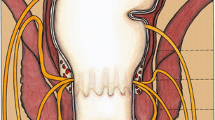Abstract
Background
Current surgical closure techniques for sphincter-sparing treatment of high cryptoglandular fistulas in the Netherlands include the mucosal advancement flap procedure (MAF) and ligation of the intersphincteric fistula tract (LIFT). A relatively novel treatment is the fistula tract laser closure (FiLaC™) method. The aim of this study was to investigate the differences in healing and recurrence rates between FiLaC™ and current standard practices.
Methods
This multicenter retrospective cohort study included both primary and recurrent high cryptoglandular anorectal fistulas, treated with either FiLaC™ or standard methods (MAF or LIFT) between September 2015 and July 2020. Patients with extrasphincteric fistulas, Crohn’s disease, multiple fistulas, age < 18 years or missing data regarding healing time or recurrence were excluded. The primary outcomes were the clinical primary and secondary healing and recurrence rates. Primary healing was defined as a closed external opening without fluid discharge within 6 months of treatment on examination, while secondary healing was the same endpoint after secondary treatment. Secondary outcomes included healing time and complaints.
Results
A total of 162 high fistulas from 3 Dutch hospitals were included. Ninety-nine high fistulas were treated with FiLaC™ and 63 with either MAF or LIFT. There were no significant differences between FiLaC™ and MAF/LIFT in terms of clinical healing (55.6% versus 58.7%, p = .601), secondary healing (70.0% versus 69.2%, p = .950) or recurrence rates (49.5% versus 54%, p = .420), respectively. Median follow-up duration was 7.1 months in the FiLaC™ group (interquartile range [IQR] 4.1–14.4 months) versus 6 months in the control group (IQR 3.5–8.1 months).
Conclusions
FiLaC™ treatment of high anorectal fistulas does not appear to be inferior to MAF or LIFT. Based on these preliminary results, FiLaC™ can be considered as a worthwhile treatment option for high cryptoglandular fistulas. Prospective studies with a longer follow-up period and well-determined postoperative parameters such as complication rates, magnetic resonance imaging for confirmation of fistula healing, incontinence and quality of life are warranted.
Similar content being viewed by others
References
Abcarian H (2011) Anorectal infection: abscess-fistula. Clin Colon Rectal Surg 24(1):14–21
Zanotti C, Martinez-Puente C, Pascual I, Pascual M, Herreros D, Garcia-Olmo D (2007) An assessment of the incidence of fistula-in-ano in four countries of the European Union. Int J Colorectal Dis 22(12):1459–1462
Sainio PP (1984) Fistula-in-ano in a defined population. Incidence and epidemiological aspects. Ann Chir Gynaecol 73(4):219–224
Parks AG, Gordon PH, Hardcastle JD (1976) A classification of fistula-in-ano. Br J Surg 63(1):1–12
Fazio VW (1987) Complex anal fistulae. Gastroenterol Clin North Am 16(1):93–114
Parks AGA (1961) Pathogenesis and treatment of fistula-in-ano. BMJ 1(5224):463–469
Gosselink MP, van Onkelen RS, Schouten WR (2015) The cryptoglandular theory revisited. Colorectal Dis 17(12):1041–1043
Wasmann KA, de Groof EJ, Stellingwerf ME, D’Haens GR, Ponsioen CY, Gecse KB et al (2020) Treatment of perianal fistulas in Crohn’s disease, seton versus anti-TNF versus surgical closure following anti-TNF [PISA]: a randomised controlled trial. J Crohns Colitis 14(8):1049–1056
Subhas G, Singh Bhullar J, Al-Omari A, Unawane A, Mittal VK, Pearlman R (2012) Setons in the treatment of anal fistula: review of variations in materials and techniques. Dig Surg 29(4):292–300
Limura E, Giordano P (2015) Modern management of anal fistula. World J Gastroenterol 21(1):12–20
Rizzo JA, Naig AL, Johnson EK (2010) Anorectal abscess and fistula-in-ano: evidence-based management. Surg Clin North Am 90(1):45–68
Nederlandse Vereniging voor Heelkunde. Richtlijn Proctologie. Chirurgische behandeling perianale fistels 2015. https://richtlijnendatabase.nl/richtlijn/proctologie/perianale_fistel_en_recidief_abces/chirurgische_behandeling_perianale_fistels.html
Elfeki H, Shalaby M, Emile SH, Sakr A, Mikael M, Lundby L (2020) A systematic review and meta-analysis of the safety and efficacy of fistula laser closure. Tech Coloproctol 24(4):265–274
Wilhelm A, Fiebig A, Krawczak M (2017) Five years of experience with the FiLaC laser for fistula-in-ano management: long-term follow-up from a single institution. Tech Coloproctol 21(4):269–276
Terzi MC, Agalar C, Habip S, Canda AE, Arslan NC, Obuz F (2018) Closing perianal fistulas using a laser: long-term results in 103 patients. Dis Colon Rectum 61(5):599–603
Frountzas M, Stergios K, Nikolaou C, Bellos I, Schizas D, Linardoutsos D et al (2020) Could FiLaC be effective in the treatment of anal fistulas? A systematic review of observational studies and proportional meta-analysis. Colorectal Dis 22:1874
Stijns J, van Loon YT, Clermonts S, Gttgens KW, Wasowicz DK, Zimmerman DDE (2019) Implementation of laser ablation of fistula tract (LAFT) for perianal fistulas: do the results warrant continued application of this technique? Tech Coloproctol 23(12):1127–1132
Garcia-Aguilar J, Belmonte C, Wong WD, Goldberg SM, Madoff RD (1996) Anal fistula surgery. Factors associated with recurrence and incontinence. Dis Colon Rectum 39(7):723–729
Lauretta A, Falco N, Stocco E, Bellomo R, Infantino A (2018) Anal fistula laser closure: the length of fistula is the Achilles’ heel. Tech Coloproctol 22(12):933–939
Stellingwerf ME, van Praag EM, Tozer PJ, Bemelman WA, Buskens CJ (2019) Systematic review and meta-analysis of endorectal advancement flap and ligation of the intersphincteric fistula tract for cryptoglandular and Crohn’s high perianal fistulas. BJS Open 3(3):231–241
Machielsen A, Iqbal N, Kimman ML, Sahnan K, Adegbola SO, Kleijnen J et al (2020) The development of a cryptoglandular Anal Fistula Core Outcome Set (AFCOS): an international Delphi study protocol. United European Gastroenterol J 8(2):220–226
Funding
No funding was received for this study.
Author information
Authors and Affiliations
Corresponding author
Ethics declarations
Conflict of interest
The authors declare they have no conflict of interest.
Ethical approval
This study was approved by the local Institutional Review Board (IRB).
Informed consent
For this type of article, informed consent was not required.
Additional information
Publisher's Note
Springer Nature remains neutral with regard to jurisdictional claims in published maps and institutional affiliations.
Rights and permissions
About this article
Cite this article
Sluckin, T.C., Gispen, W.H., Jongenotter, J. et al. Treatment of cryptoglandular fistulas with the fistula tract laser closure (FiLaC™) method in comparison with standard methods: first results of a multicenter retrospective comparative study in the Netherlands. Tech Coloproctol 26, 797–803 (2022). https://doi.org/10.1007/s10151-022-02644-7
Received:
Accepted:
Published:
Issue Date:
DOI: https://doi.org/10.1007/s10151-022-02644-7




